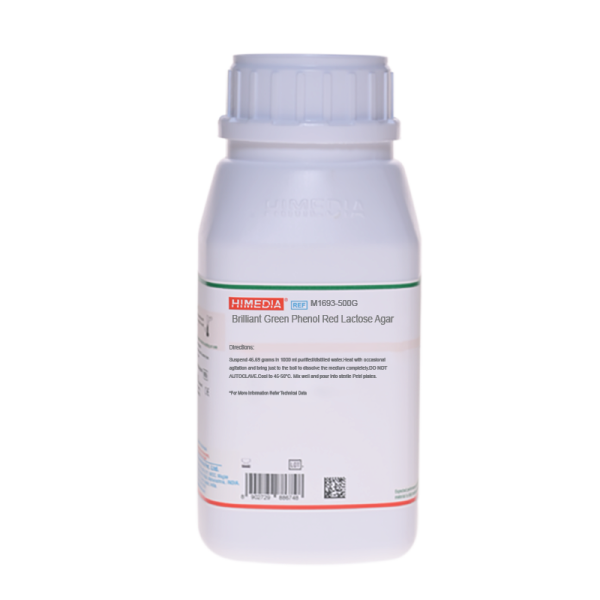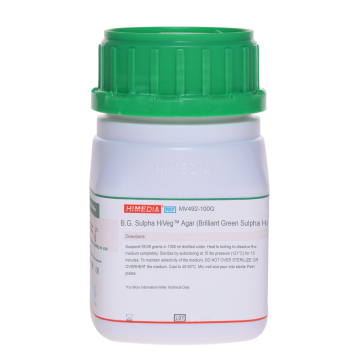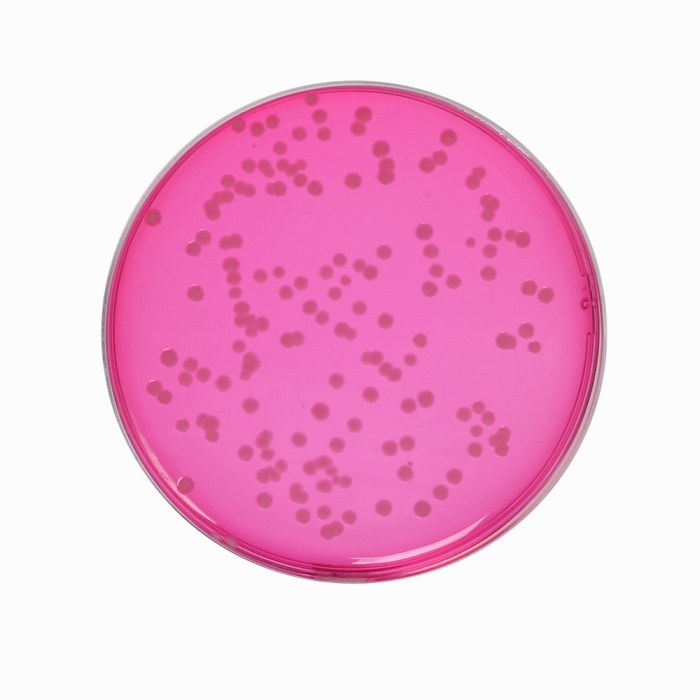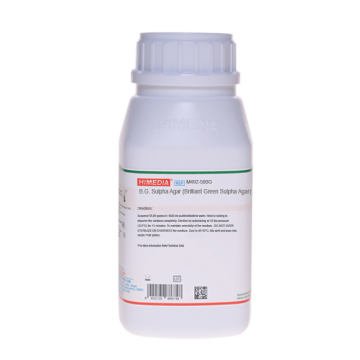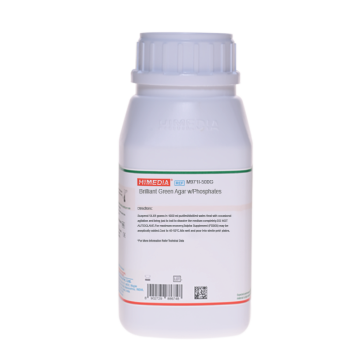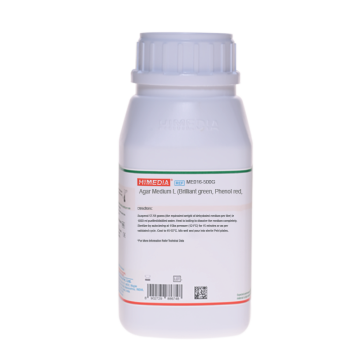 Your enquiry has been submitted
Your enquiry has been submitted
Brilliant Green Phenol Red Lactose Agar
Brilliant Green Phenol Red Lactose Agar is used for selective isolation of Salmonella species from water samples.
Composition**
| Ingredients | Gms / Litre |
|---|---|
| Meat extract | 5.000 |
| Peptone, enzymatic digest of animal tissue | 5.000 |
| Disodium hydrogen phosphate | 1.000 |
| Sodium dihydrogen phosphate | 0.600 |
| Lactose | 10.000 |
| Sucrose | 10.000 |
| Phenol red | 0.090 |
| Brilliant green | 0.005 |
| Agar | 15.000 |
Final pH ( at 25°C): 7.0±0.1
**Formula adjusted, standardized to suit performance parameters
Directions
Suspend 46.69 grams in 1000 ml distilled water. Heat with occasional agitation and bring just to the boil to dissolve the medium completely. DO NOT AUTOCLAVE. Cool to 50°C. Mix well and pour into sterile Petri plates.
Principle And Interpretation
This medium is formulated according to Edel and Kampelmacher (1, 2) for selective isolation of Salmonella species from water and is recommended by ISO specifications ISO 6340; 1995 / IS15187; 2002 (3). Solid selective media are used after the liquid enrichment steps for detection and isolation of Salmonella species. In order to increase the probability of detecting Salmonella organisms, at least two different medias are inoculated from selective enrichment cultures. This includes Brilliant green phenol red lactose agar (M1693), XLD agar (M031/M031I) or Bismuth sulphite agar (M027). The occurrence of typical colonies of Salmonella species on selective agar media is not sufficient evidence for the presence of Salmonella species. Therefore it is necessary to subculture presumptive Salmonella colonies on different media for biochemical and serological confirmation (3).
Water samples collected should be analysed within 24 hours. For water samples exceeding 10 ml in volume, add the sample to the same volume of buffered peptone water (M614/M614S) (double strength) or filter through a sterile membrane filter and place in 50 ml buffered peptone water (single strength). Filtering aids can be used when needed. For sample volumes of 10 ml or less, use a minimum of 50 ml of buffered peptone water (single strength) or atleast 10 times the volume of the sample. Incubate at 36 ± 2°C for 16 -20 hours.
For further enrichment in selective media transfer 0.1 ml of preenrichment culture to 10 ml or 1 ml to 100 ml of Malachite green/ magnesium chloride medium i.e Modified Rappaport Vassiliadis medium (M1658I) for water testing and incubate in a water bath at 42 ± 0.5°C for 18-24 h. The larger volume of inoculum might increase the probability of detecting Salmonella organisms. In certain situations, the use of selenite cystine medium (M025) in addition to malachite green / magnesium chloride medium is recommended. Place a loopful of enrichment medium onto Brilliant Green Phenol Red Lactose Agar (M1693) and XLD agar (M031/M031I). Bismuth Sulphite Agar (M027) can be used an optional medium. Place in incubator at 36 +/- 2°C for 24 h -48 h for Bismuth Sulphite Agar. For confirmation take all (or atleast five of) the distinct typical Salmonella colonies from each positive agar medium). Colonies on Brilliant Green Phenol Red Lactose Agar (M1693) which are red or slightly pink-white and opaque with red surroundings. Colonies on XLD which are colourless (but appear red) usually with black centre. Black colonies on Bismuth Sulphite Agar usually surrounded by metallic sheen.
Plate out the selected colonies onto the surface of predried nutrient agar plates (M561A) in manner which will allow well isolated colonies to develop. Place these plates in an incubator at 36 ± 2°C for 18 h to 24 h. Use single isolated colonies only. Basic biochemical reactions for confirmation of Salmonella species must be studied which includes Lactose (negative) and Glucose (positive) fermentation reaction, Hydrogen sulphide production (positive), Urea negative and Lysine decarboxylase (positive) reactions.
Quality Control
Appearance Light yellow to light pink homogeneous free flowing powder
Gelling Firm, comparable with 1.5% agar gel.
Colour and Clarity of Prepared medium Greenish brown coloured, clear to slightly opalescent gel forms in Petri plates
Reaction Reaction of 4.66% w/v aqueous solution at 25°C. pH : 7.0±0.1
pH 6.90-7.10
Cultural Response Cultural characteristics observed after an incubation at 35-37°C for 18-24 hours.
| Organism | Inoculum (CFU) | Growth | Recovery | Colour of Colony |
|---|---|---|---|---|
| Salmonella Typhimurium ATCC 14028 | 50-100 | luxuriant | >=50% | red or slightly pink-white and opaque with red surroundings |
| Salmonella Enteritidis ATCC 13076 | 50-100 | luxuriant | >=50% | red or slightly pink-white and opaque with red surroundings |
| Escherichia coli ATCC 25922 | 50-100 | none-poor | <=10% |
Storage and Shelf Life
Store below 30°C in tightly closed container and the prepared medium at 2 - 8°C. Use before expiry date on the label.
Reference
- Edel W. and Kampelmacher E.H., 1969, Bull. W.H.O., 41:297.
- Edel W. and Kampelmacher E.H., 1969, Bull. W.H.O., 39:487.
- Water Quality- Detection of Salmonella species, International Organization for Standardization, ISO 6340-1995/ IS 15187:2002
| Product Name | Brilliant Green Phenol Red Lactose Agar |
|---|---|
| SKU | M1693 |
| Product Type | Regular |
| Physical Form | Powder |
| Origin | Animal |
| Packaging type | HDPE |
| References | 1.Edel W. and Kampelmacher E.H., 1969, Bull. W.H.O., 41:297.2.Edel W. and Kampelmacher E.H., 1969, Bull. W.H.O., 39:487.3.Water Quality- Detection of Salmonella species, International Organization for Standardization, ISO 6340-1995/ IS15187:2002 |
| Customized Product Available | No |



